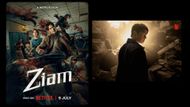Ziam invites viewers into scorched streets filled with riot smoke and a city choking on thirst and hunger. Each frame pulses with heat, each face carries the weight of betrayal and survival.
Director Kulp Kaljareuk builds a world that breathes like a wounded beast, each movement echoing despair and raw defiance. Instead of safe rooftops or clean escape routes, Ziam unfolds through dripping corridors, shattered glass, and flesh splitting under flickering lights.
The film carves away comfort and drags each heartbeat into a fever dream where society crumbles from the inside. Every elbow and knee from Singh strikes like a sacred chant carved in sweat and blood. Dr. Rin’s eyes burn through waves of infected bodies, and Buddy glides through the labyrinth of horror with a fragile but stubborn pulse of hope.
Ziam rises as a brutal testament to the hunger living in systems, in whispered promises, and in every silent pact that dissolves when fear takes the throne.

A city already on the brink
Ziam captures a Thailand already on its knees long before the first bite. Water stands contaminated, food vanishes from shelves, and chaos floods every street corner. The film frames these riots not as background noise but as the heartbeat of collapse. Each protest sign, each shattered storefront window, echoes a country screaming under greed and neglect.
Director Kulp Kaljareuk fills every shot with sweat and grime. The heat vibrates against concrete walls, and each close-up reveals the terror stitched into the skin. This is not a sterile outbreak. It feels intimate, heavy, and deeply human. The riots gnaw at the viewer with more force than any infected jaw.
The infection arrives under the twisted guise of salvation. Vasu’s fish promise comfort and nourishment but instead sow the seeds of violence that pulses under fluorescent hospital lights and echoing alleyways. The film presses each gasp, each stumble, into the viewer’s lungs, forcing them to inhale the same poisoned air.

The family as battlefield
At the core of Ziam stands a family splintered by fear and devotion. Dr. Rin remains inside the hospital, moving through infected corridors with relentless urgency. Her presence slices through chaos like a blade, each movement weighted with grit rather than mercy. Singh fights beyond the walls, then inside them, each elbow and knee smashing through the infected like living declarations of love and rage.
Buddy becomes a quiet axis around which both characters orbit. His small steps mark the thin thread connecting violence and tenderness. Each shot of Buddy weaving between blood-soaked beds and broken tiles carries a ghostly intensity, hinting at the fragile pulse of hope in a space devoured by ruin.
Kulp Kaljareuk uses these three bodies as emotional landmarks. Their separation fractures the narrative into tense beats, each reunion and near-miss throbbing under the city’s burning sky. Every glance and staggered breath feels raw, each reunion envisioned not as triumph but as a reminder of how quickly warmth can vanish when hunger surrounds every wall.

Ziam: The fever of collapse
Ziam devours any illusion of safety. The film carves through each scene with the sharpness of shattered glass, flooding us with textures of sweat, fire, and concrete dust. Each scream drips with betrayal, each alleyway pulses with a hunger that grows louder than any siren.
The camera breathes inside every wound. Hallways glow under emergency lights, skin burns under the pulse of explosions, and violence flows as both choreography and primal instinct. Singh’s fists echo like war drums, Dr. Rin’s focus holds the weight of a last heartbeat, and Buddy moves as a phantom thread tying them to a fading world.
Kulp Kaljareuk refuses soft landings. The film grows hotter with every frame, each choice screaming louder than any infected roar. By the time flames lick across bodies and the building, the viewer already feels each muscle torn and each gasp chiseled into the skull.
Ziam pulls every nerve forward, forcing each eye to tremble with the knowledge that collapse feels intimate and endless when carved through bodies and betrayals.

The echo beyond the flames
Ziam rises beyond a simple infection story. The film gnaws into questions of trust, power, and the silent deals that shape a society already gasping before the first bite. Each burnt corridor and each crawling figure whisper that no system crumbles only through violence. Decay begins in quiet rooms where greed grows unchecked and promises taste sweeter than clean water.
The final images refuse comfort. Survivors carry ghosts in their veins, eyes reflecting corridors that will never empty. Each breath feels heavy with ash and betrayal. The title Ziam echoes this inheritance, transforming Siam into a land gnawed hollow, where no anthem shields against the slow violence of hunger and fear.
Kulp Kaljareuk offers no crown to the last heartbeat. Instead, he builds an elegy for a world gnawed from the inside, a place where fire only sharpens the outline of what humanity leaves behind.
In the end, Ziam does not promise rebirth. It delivers a grave hymn for those who walk forward carrying both the fire and the scars it leaves behind.
Rating with a touch of flair: 5 out of 5 zombies in flames
You might also like to read: Ziam ending explained: there’s no cure for a world already rotten - uncover the final scars left by Ziam, the echo of burning ghosts, and the hunger that shapes every silent choice.
Love movies? Try our Box Office Game and Movie Grid Game to test your film knowledge and have some fun!
